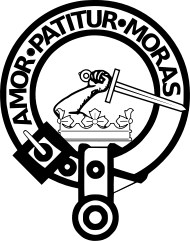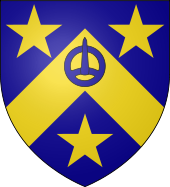- Clan Lumsden
-
Clan Lumsden Crest badge 
Crest: Issuant from a crest coronet Or a naked arm grasping a sword Proper Motto: Amor patitur moras Profile Region Borders District Berwickshire Chief

Gillem Lumsden of that Ilk and Blanerne Chief of the Name and Arms of Lumsden Seat Stapely House, Berkshire Historic seat Lumsden Castle Clan Lumsden is a Lowland Scottish clan.
Contents
History
Origins of the clan
The name Lumsden derives from the old manor of Lumsden in the parish of Coldingham in Berwickshire. The earliest known recordings of the name appear between 1166 and 1182 when the brothers Gillem (William) and Cren de Lumsden witnessed a charter by Waldeve Earl of Dunbar to Coldingham Priory. The lands of Lumsden are first mentioned in a charter dated 1098 of King Edgar of Scotland and his son Malcolm Canmore. Gillem and his brother Cren are the first recorded owners of the land.
In 1296 Adam Lumsden and Roger de Lumsden were among the Scottish clan leaders who were forced to do homage to King Edward I of England with both of their names appearing on the Ragman Rolls.
Fourteenth century
Around 1328 Gillbert de Lumsden married an heiress of Blanerne and by 1329 had received a charter for the Blanerne lands by the Earl of Angus. By the mid fourteenth century offshoots of the Lumsden clan had charters and lands confirmed to them in Conlan in Fife and Medlar and Cushnie in Aberdeenshire.
Seventeenth century, Thirty Years' War and Civil War
Thirty Years' War
In the early seventeenth century during the Thirty Years' War the Clan Lumsden fought for the Swedish King Gustavus Adolphus in a famous unit called "Lumsden's Musketeers".
The Civil War
One of the Lumsden brothers, James Lumsden returned from the war in Europe with his men to fight in the Civil War which was taking place in England, Ireland and Scotland to support the Covenanters. They fought at the Battle of Marston Moor in 1644 where King Charles I was defeated. They also fought at the Battle of Dunbar (1650) under David Leslie where the Covenanters were defeated by the Parliamentarians.
James Lumsden's brother Robert defended Dundee against General Monck but he was killed on its surrender.
Eighteenth century and Jacobite uprisings
During the Jacobite Uprisings of 1745 to 1746 the Chief of Clan Lumsden was Prince Charles Edward Stuart's secretary. After the Battle of Culloden the chief fled to Rome. He returned to Scotland in 1773 and was pardoned by the British government. His tartan waistcoat is preserved at Pitcaple Castle.
Castles and clan seat
- Blanerne Castle in Berwickshire, was acquired in the fourteenth century and was the main clan seat.
- Pitcaple Castle in Cushnie, Alford and Tillycairn Castle in Cluny were also owned by the Clan Lumsden.
See also
External links
- http://www.electricscotland.com/webclans/htol/lumsden2.html
- http://www.myclan.com/clans/Lumsden_68/default.php
Scottish clans Clans with chiefs Agnew · Anstruther · Arbuthnott · Arthur · Bannerman · Barclay · Borthwick · Boyd · Boyle · Brodie · Broun · Bruce · Buchan · Burnett · Cameron · Campbell · Carmichael · Carnegie · Cathcart · Charteris · Chattan · Chisholm · Cochrane · Colquhoun · Colville · Cranstoun · Crichton · Cumming · Darroch · Davidson · Dewar · Drummond · Dunbar · Dundas · Durie · Elliot · Elphinstone · Erskine · Farquharson · Fergusson · Forbes · Forsyth · Fraser · Fraser of Lovat · Gayre · Gordon · Graham · Grant · Gregor · Grierson · Guthrie · Haig · Haldane · Hamilton · Hannay · Hay · Henderson · Home · Hope · Hunter · Irvine · Jardine · Johnstone · Keith · Kennedy · Kerr · Kincaid · Lamont · Leask · Lennox · Leslie · Lindsay · Lockhart · Lumsden · Lyon · MacAlister · MacBain · MacDonald · Macdonald of Clanranald · MacDonald of Keppoch · Macdonald of Sleat · MacDonell of Glengarry · MacDougall · Macdowall · MacIntyre · Mackay · Mackenzie · Mackinnon · Mackintosh · Maclachlan · Maclaine of Lochbuie · MacLaren · MacLea (Livingstone) · Maclean · MacLennan · MacLeod · MacLeod of Lewis · MacMillan · Macnab · Macnaghten · MacNeacail · MacNeil · Macpherson · MacTavish · MacThomas · Maitland · Makgill · Malcolm (MacCallum) · Mar · Marjoribanks · Matheson · Menzies · Moffat · Moncreiffe · Montgomery · Morrison · Munro · Murray · Napier · Nesbitt · Nicolson · Ogilvy · Oliphant · Primrose · Ramsay · Rattray · Riddell · Robertson · Rollo · Rose · Ross · Ruthven · Sandilands · Scott · Scrymgeour · Sempill · Shaw · Sinclair · Skene · Spens · Stirling · Strange · Stuart of Bute · Sutherland · Swinton · Trotter · Urquhart · Wallace · Wedderburn · Wemyss · Wood ·
Armigerous clans Abercromby · Abernethy · Adair · Adam · Aikenhead · Ainslie · Aiton · Allardice · Anderson · Armstrong · Arnott · Auchinleck · Baillie · Baird · Balfour · Bannatyne · Baxter · Bell · Belshes · Bethune · Beveridge · Binning · Bissett · Blackadder · Blackstock · Blair · Blane · Blyth · Boswell · Brisbane · Buchanan · Butter · Byres · Cairns · Calder · Caldwell · Callender · Campbell of Breadalbane · Campbell of Cawdor · Carruthers · Cheyne · Chalmers · Clelland · Clephane · Cockburn · Congilton · Craig · Crawford · Crosbie · Cunningham · Dalmahoy · Dalrymple · Dalzell · Dennistoun · Don · Douglas · Duncan · Dunlop · Edmonstone · Fairlie · Falconer · Fenton · Fleming · Fletcher · Forrester · Fotheringham · Fullarton · Galbraith · Galloway · Gardyne · Gartshore · Ged · Gibsone · Gladstains · Glas · Glen · Glendinning · Gray · Gunn · Haliburton · Halkerston · Halket · Hepburn · Heron · Herries · Hogg · Hopkirk · Horsburgh · Houston · Hutton · Inglis · Innes · Kelly · Kinloch · Kinnaird · Kinnear · Kinninmont · Kirkcaldy · Kirkpatrick · Laing · Lammie · Langlands · Learmonth · Little · Logan · Logie · Lundin · Lyle · MacAulay · Macbrayne · MacDuff · MacEwen · MacFarlane · Macfie · Macgillivray · MacInnes · MacIver · Mackie · MacLellan · Macquarrie · Macqueen · Macrae · Masterton · Maule · Maxton · Maxwell · McCorquodale · McCulloch · McKerrell · Meldrum · Melville · Mercer · Middleton · Moncur · Monteith · Monypenny · Mouat · Moubray · Mow · Muir · Murray of Atholl · Nairn · Nevoy · Newlands · Newton · Norvel · Ochterlony · Orrock · Paisley · Paterson · Pennycook · Pentland · Peter · Pitblado · Pitcairn · Pollock · Polwarth · Porterfield · Preston · Pringle · Purves · Rait · Ralston · Renton · Roberton · Rossie · Russell · Rutherford · Schaw · Seton · Skirving · Somerville · Spalding · Spottiswood · Stewart · Stewart of Appin · Strachan · Straiton · Strange · Sydserf · Symmers · Tailyour · Tait · Tennant · Troup · Turnbull · Tweedie · Udny · Vans · Walkinshaw · Wardlaw · Watson · Wauchope · Weir · Whitefoord · Whitelaw · Wishart · Young
Culture and society Scotland · Clan chief · Septs · Clan badge · Clan crest · Clan battles · Tartan · Bagpipes · Clearances · Kilt · Manrent · The Highlands · Battle of Culloden · Highland games · Border Reivers · Scottish heraldry · Scottish surnames
Categories:- Scottish clans
Wikimedia Foundation. 2010.
